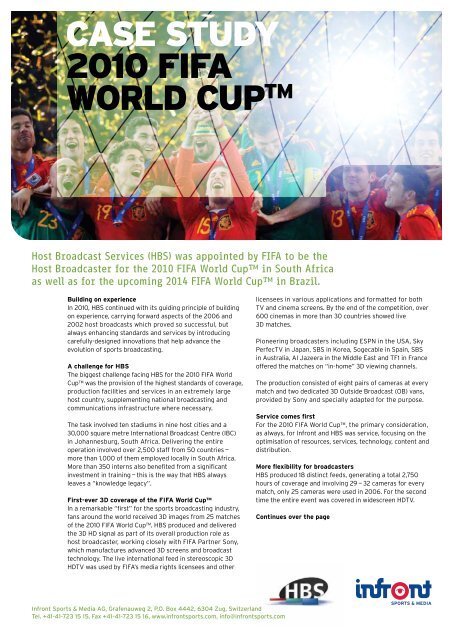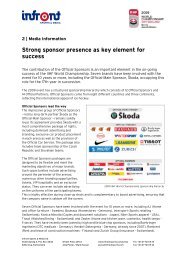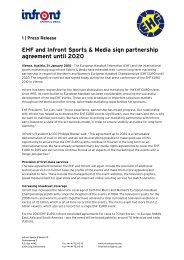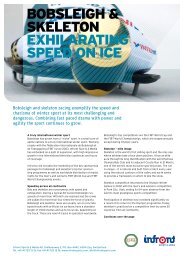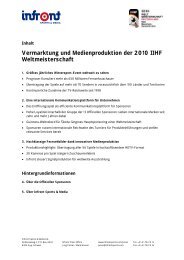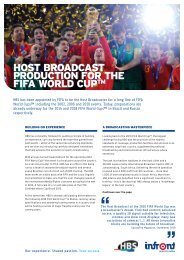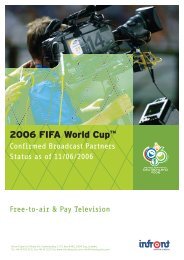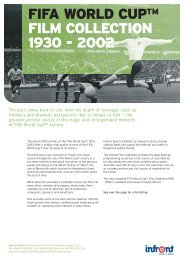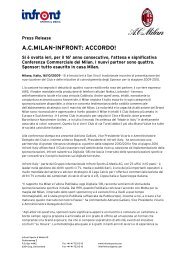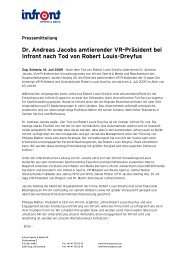CASE STUDY 2010 FIFA WORLD CUPTM - Infront
CASE STUDY 2010 FIFA WORLD CUPTM - Infront
CASE STUDY 2010 FIFA WORLD CUPTM - Infront
You also want an ePaper? Increase the reach of your titles
YUMPU automatically turns print PDFs into web optimized ePapers that Google loves.
<strong>CASE</strong> <strong>STUDY</strong><br />
<strong>2010</strong> <strong>FIFA</strong><br />
<strong>WORLD</strong> CUP TM<br />
Host Broadcast Services (HBS) was appointed by <strong>FIFA</strong> to be the<br />
Host Broadcaster for the <strong>2010</strong> <strong>FIFA</strong> World Cup in South Africa<br />
as well as for the upcoming 2014 <strong>FIFA</strong> World Cup in Brazil.<br />
Building on experience<br />
In <strong>2010</strong>, HBS continued with its guiding principle of building<br />
on experience, carrying forward aspects of the 2006 and<br />
2002 host broadcasts which proved so successful, but<br />
always enhancing standards and services by introducing<br />
carefully-designed innovations that help advance the<br />
evolution of sports broadcasting.<br />
A challenge for HBS<br />
The biggest challenge facing HBS for the <strong>2010</strong> <strong>FIFA</strong> World<br />
Cup was the provision of the highest standards of coverage,<br />
production facilities and services in an extremely large<br />
host country, supplementing national broadcasting and<br />
communications infrastructure where necessary.<br />
The task involved ten stadiums in nine host cities and a<br />
30,000 square metre International Broadcast Centre (IBC)<br />
in Johannesburg, South Africa. Delivering the entire<br />
operation involved over 2,500 staff from 50 countries —<br />
more than 1,000 of them employed locally in South Africa.<br />
More than 350 interns also benefited from a significant<br />
investment in training — this is the way that HBS always<br />
leaves a “knowledge legacy”.<br />
First-ever 3D coverage of the <strong>FIFA</strong> World Cup<br />
In a remarkable “first” for the sports broadcasting industry,<br />
fans around the world received 3D images from 25 matches<br />
of the <strong>2010</strong> <strong>FIFA</strong> World Cup. HBS produced and delivered<br />
the 3D HD signal as part of its overall production role as<br />
host broadcaster, working closely with <strong>FIFA</strong> Partner Sony,<br />
which manufactures advanced 3D screens and broadcast<br />
technology. The live international feed in stereoscopic 3D<br />
HDTV was used by <strong>FIFA</strong>’s media rights licensees and other<br />
<strong>Infront</strong> Sports & Media AG, Grafenauweg 2, P.O. Box 4442, 6304 Zug, Switzerland<br />
Tel. +41-41-723 15 15, Fax +41-41-723 15 16, www.infrontsports.com, info@infrontsports.com<br />
licensees in various applications and formatted for both<br />
TV and cinema screens. By the end of the competition, over<br />
600 cinemas in more than 30 countries showed live<br />
3D matches.<br />
Pioneering broadcasters including ESPN in the USA, Sky<br />
PerfecTV in Japan, SBS in Korea, Sogecable in Spain, SBS<br />
in Australia, Al Jazeera in the Middle East and TF1 in France<br />
offered the matches on “in-home” 3D viewing channels.<br />
The production consisted of eight pairs of cameras at every<br />
match and two dedicated 3D Outside Broadcast (OB) vans,<br />
provided by Sony and specially adapted for the purpose.<br />
Service comes first<br />
For the <strong>2010</strong> <strong>FIFA</strong> World Cup, the primary consideration,<br />
as always, for <strong>Infront</strong> and HBS was service, focusing on the<br />
optimisation of resources, services, technology, content and<br />
distribution.<br />
More flexibility for broadcasters<br />
HBS produced 18 distinct feeds, generating a total 2,750<br />
hours of coverage and involving 29 — 32 cameras for every<br />
match, only 25 cameras were used in 2006. For the second<br />
time the entire event was covered in widescreen HDTV.<br />
Continues over the page
<strong>CASE</strong> <strong>STUDY</strong><br />
<strong>2010</strong> <strong>FIFA</strong><br />
<strong>WORLD</strong> CUP TM<br />
In 2002 and 2006, the Basic International Feed (BIF) and the<br />
Extended Stadium Feed (ESF) were produced separately. For <strong>2010</strong>,<br />
both feeds were merged — offering broadcasters more content and<br />
more flexibility.<br />
Dedicated mobile content production<br />
The mobile content of the 2006 <strong>FIFA</strong> World Cup was made up<br />
entirely of in-match clips (such as short goal videos) and did much to<br />
highlight the possibilities for mobile video at major sporting events.<br />
Technical advancements in <strong>2010</strong> revealed a different landscape with<br />
global 3G proliferation and video-friendly handsets creating a huge<br />
opportunity for mobile content production. The innovative mobile<br />
packages produced contained tailored content, specific to the<br />
requirements of the mobile network operators, users and mobile<br />
football fans around the world.<br />
The latest technical solutions ensured the images produced were<br />
suitable for tiny screens as provisions were put in place to use mobile<br />
specific cameras for the matches and “Pan & Scan” technology in<br />
the post-production process.<br />
Billions of viewers in hundreds of countries<br />
At the end of the <strong>2010</strong> <strong>FIFA</strong> World Cup, HBS was responsible for<br />
sending HDTV signals to a cumulative audience of 26 billion viewers<br />
in 214 countries.<br />
High quality TV features<br />
Every participating team was allocated an electronic news gathering<br />
crew (ENG) — amounting to a total of 32 crews — along with ten<br />
additional crews for <strong>FIFA</strong> TV features, making it an operation of<br />
unprecedented scale. This gave broadcasters an extensive range and<br />
variety of very high quality material. The feature footage gathered<br />
was incorporated into the popular EBIF show, offered to broadcasters.<br />
<strong>FIFA</strong> Max Centre — “the hit of the games”<br />
The hugely successful Media Server, introduced in 2006, was<br />
described as “the hit of the games”. Renamed the <strong>FIFA</strong> Max Centre,<br />
it enabled <strong>FIFA</strong> Licensees (MRL’s) to access over 3,000 hours of<br />
<strong>2010</strong> <strong>FIFA</strong> World Cup footage from a dedicated set-up, including<br />
the ability to browse, log and exchange match material and access<br />
additional colour material gathered by <strong>FIFA</strong> TV ENG crews as well<br />
as the archiving service.<br />
Award recognition for 3D innovation<br />
In recognition of the major achievement in terms of 3D coverage, HBS<br />
has received three renowned and important industry awards in <strong>2010</strong>.<br />
Along with <strong>FIFA</strong>, Sony, and ESPN, HBS jointly won the prestigious<br />
Judges’ Award — one of the IBC’s Innovation Awards, at the IBC — RAI<br />
Convention Centre in Amsterdam. IBC is the leading international<br />
forum for the electronic media industry. The four partners received<br />
the special prize titled “The <strong>2010</strong> <strong>FIFA</strong> World Cup in 3D” in<br />
recognition of their collaboration<br />
HBS not only delivered the exceptional 3D experience together<br />
with its partners, but also provided broadcasters from all over the<br />
world with a high quality 2D feed for all 64 matches of the <strong>2010</strong> <strong>FIFA</strong><br />
World Cup. Its strong performance and technical excellence at the<br />
tournament was honoured by the Sports Video Group in its 5th<br />
annual Sport Technology Reception at the IBC.<br />
Additionally, HBS was again recognised at the 6th edition of the<br />
Association for International Broadcasting (AIB) Awards, where<br />
alongside Sony Professional, it jointly won the “The Most Innovative<br />
Technology” Award. The acknowledgment praised the “sheer<br />
innovation” required to deliver the world’s first 3D World Cup and<br />
the entry was considered as “game-changing” — delivering a<br />
completely new experience in the world of sports television.<br />
Awards <strong>2010</strong><br />
Judges Award<br />
“The Host Broadcast of the <strong>2010</strong> <strong>FIFA</strong> World<br />
Cup was a broadcaster’s dream. Enriched<br />
content; enhanced access; a quality 3D signal<br />
suitable for television, cinemas and show<br />
room displays; many new variations of<br />
cameras […]. All these innovative blocks are<br />
building the future of broadcast.”<br />
SportsPro Magazine, September <strong>2010</strong>


